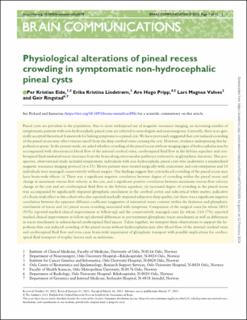Physiological alterations of pineal recess crowding in symptomatic non-hydrocephalic pineal cysts
Peer reviewed, Journal article
Published version
Permanent lenke
https://hdl.handle.net/11250/3115594Utgivelsesdato
2023Metadata
Vis full innførselSamlinger
Sammendrag
Pineal cysts are prevalent in the population. Due to more widespread use of magnetic resonance imaging, an increasing number of
symptomatic patients with non-hydrocephalic pineal cysts are referred to neurologists and neurosurgeons. Currently, there is no gen-
erally accepted theoretical framework for linking symptoms to a pineal cyst. We have previously suggested that cyst-induced crowding
of the pineal recess may affect venous runoff from the deep cerebral veins crossing the cyst. However, evidence underpinning this hy-
pothesis is sparse. In the present study, we asked whether crowding of the pineal recess without imaging signs of hydrocephalus may be
accompanied with alterations in blood flow of the internal cerebral veins, cerebrospinal fluid flow in the Sylvian aqueduct and cere-
brospinal fluid-mediated tracer clearance from the brain along extravascular pathways (referred to as glymphatic function). This pro-
spective, observational study included symptomatic individuals with non-hydrocephalic pineal cysts who underwent a standardized
magnetic resonance imaging protocol (n = 25): Eleven patients were treated surgically with craniotomy and cyst extirpation and 14
individuals were managed conservatively without surgery. Our findings suggest that cyst-induced crowding of the pineal recess may
have brain-wide effects: (i) There was a significant negative correlation between degree of crowding within the pineal recess and
change in maximum venous flow velocity at the cyst, and a significant positive correlation between maximum venous flow velocity
change at the cyst and net cerebrospinal fluid flow in the Sylvian aqueduct; (ii) increased degree of crowding in the pineal recess
was accompanied by significantly impaired glymphatic enrichment in the cerebral cortex and subcortical white matter, indicative
of a brain-wide effect in this cohort who also reported markedly impaired subjective sleep quality; (iii) there was a significant negative
correlation between the apparent diffusion coefficient (suggestive of interstitial water content) within the thalamus and glymphatic
enrichment of tracer and (iv) pineal recess crowding associated with symptoms. Comparison of the surgical cases [in whom 10/11
(91%) reported marked clinical improvement at follow-up] and the conservatively managed cases [in whom 1/14 (7%) reported
marked clinical improvement at follow-up] showed differences in pre-treatment glymphatic tracer enrichment as well as differences
in tracer enrichment in subarachnoid cerebrospinal fluid spaces. Taken together, we interpret these observations to support the hy-
pothesis that cyst-induced crowding of the pineal recess without hydrocephalus may alter blood flow of the internal cerebral veins
and cerebrospinal fluid flow and even cause brain-wide impairment of glymphatic transport with possible implications for cerebro-
spinal fluid transport of trophic factors such as melatonin.

